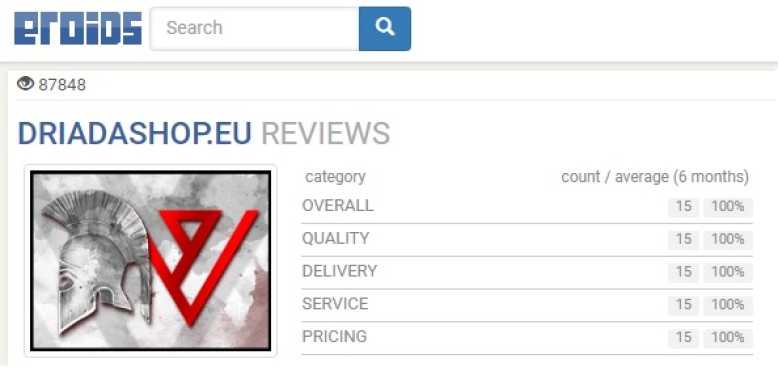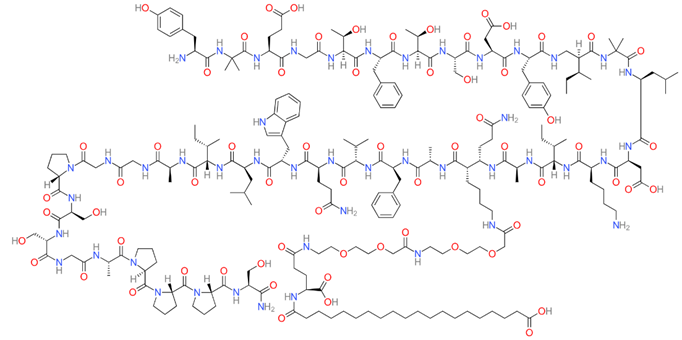
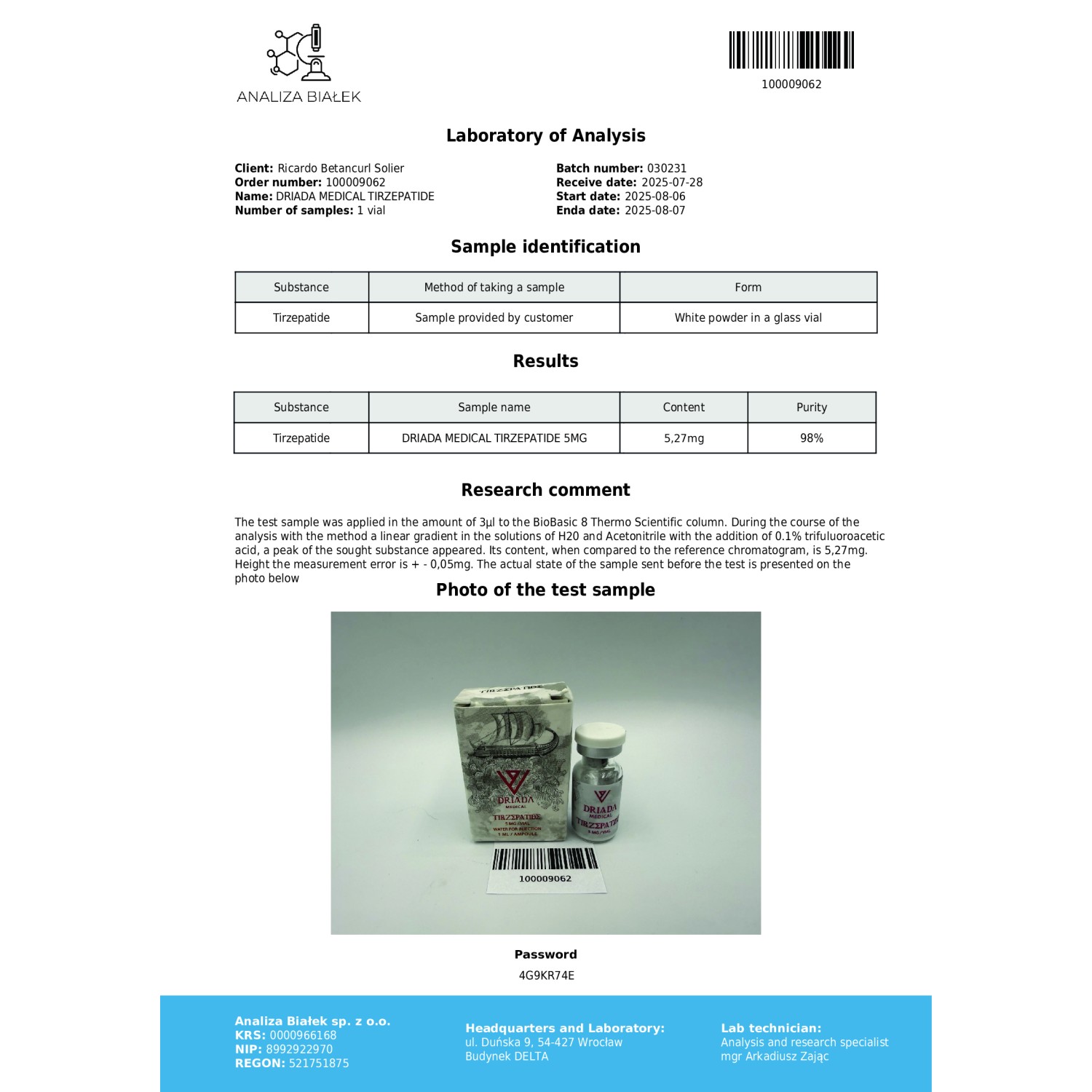
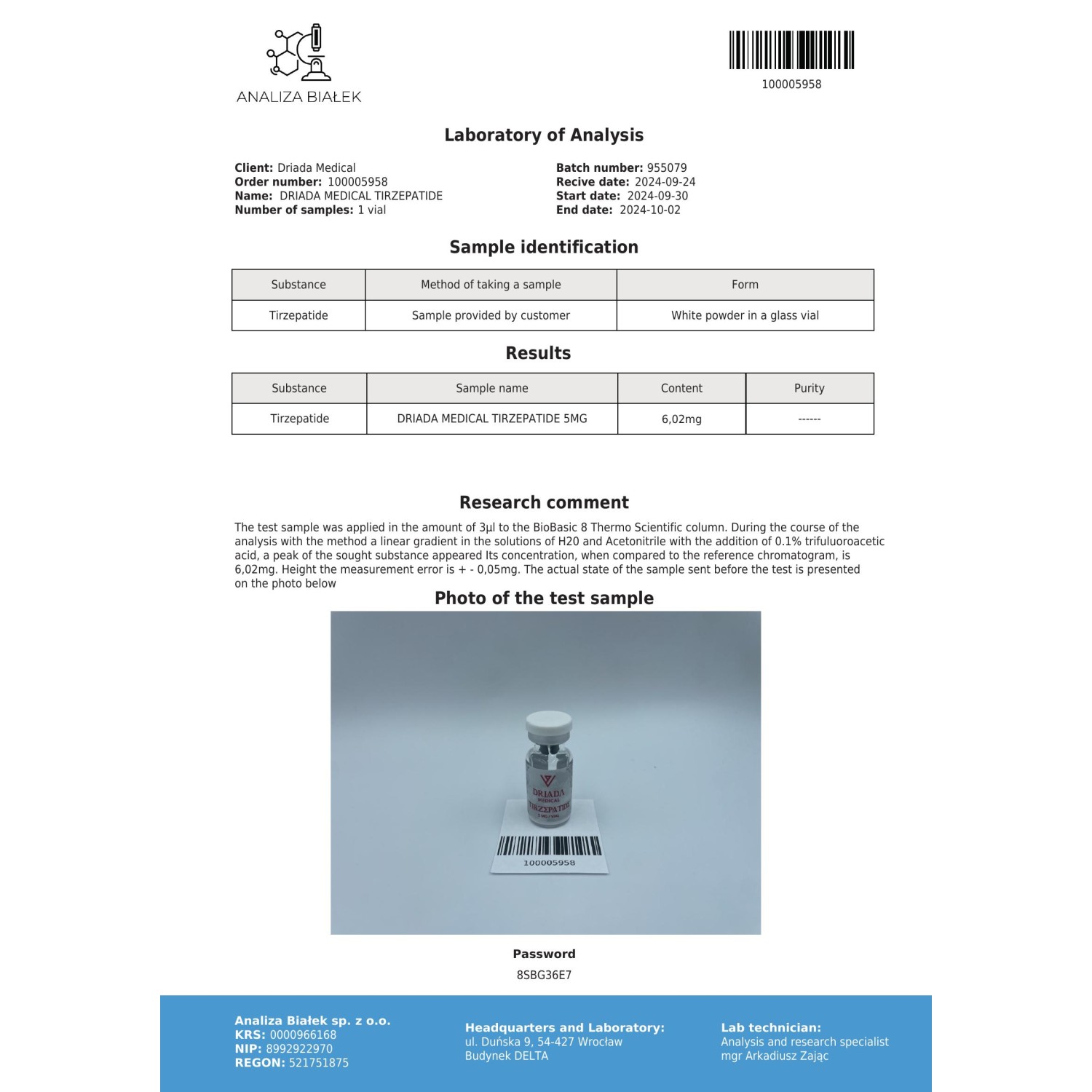



- Stock: In Stock
- Package: 5mg Vial + 1ml water
This offer ends in:
Category: Peptide
-
Purpose: Weight loss, appetite control
-
Form: Vial with lyophilized powder + 1 ml ampoule of bacteriostatic water for reconstitution
-
Administration: Subcutaneous injection
What is Tirzepatide?
Tirzepatide is an innovative drug designed to treat type 2 diabetes and obesity. It activates two receptors in the body: GIP and GLP-1, which help regulate blood sugar, appetite, and fat storage. By working on both of these hormone pathways, Tirzepatide helps lower blood glucose and encourages significant weight loss. It's more effective than many older treatments and is being explored for additional uses beyond diabetes. Finally, you can find Tirzepatide in our shop, making it easier than ever to access this powerful treatment for weight loss and blood sugar control.
Main effects of Tirzepatide
🍽️ Reduced appetite — Slows how fast food leaves your stomach, making you feel full longer and naturally eat less
📉 Weight loss — Helps lower body weight by improving how your body uses energy and reducing calorie intake.
🩸 Better blood sugar control — Supports the body's natural insulin response, helping to keep blood sugar levels stable and lower over time.
🫀 Heart and metabolism support — May help reduce blood pressure, improve cholesterol, and calm low-grade inflammation in the body
How to take Tirzepatide?
Tirzepatide comes in a vial containing 5 mg of lyophilized powder. If you plan to buy Tirzepatide, note that it must be reconstituted using the provided bacteriostatic water before use. You can read detailed instructions on how to prepare peptides and perform injections HERE.
Dosing schedule
| Week | Dosage | Notes |
|---|---|---|
| 1–4 | 2.5 mg once weekly | Start dose. Helps the body get used to the drug and reduces nausea. |
| 5+ | 5 mg once weekly | Increase if no major side effects. |
| 9+ | 7.5 mg, 10 mg, 12.5 mg, up to 15 mg | Increase in steps every 4+ weeks if needed. Stay at the lowest dose that works well for you. |
Tirzepatide can be used for long periods — in clinical settings, people have taken it for over a year without issues. If the drug works well and side effects are minimal, many choose to stay on a stable dose for months or longer. It’s very important to pay attention to how you feel while using Tirzepatide, watch for side effects, and avoid overusing it. Long-term use is possible, but it’s best to stay on the lowest dose that works well and take breaks if needed.
Can be taken at any time of day, with or without food.
If you miss a dose, take it within 4 days (96 hours); otherwise skip it and continue as usual.
Precautions
- Do not use if you or a family member has had medullary thyroid cancer or MEN2 syndrome.
- Not for people with type 1 diabetes or a history of pancreatitis.
- Avoid during pregnancy or breastfeeding.
- Don't combine with other GLP-1 receptor agonists (like semaglutide or retatrutide).
Possible side effects
Some side effects are more common than others. Here's what people typically report:
Very common (10% or more):
- Nausea
- Diarrhea
- Reduced appetite
- Tiredness
- Indigestion
Common (1–10%):
- Vomiting
- Constipation
- Stomach pain or bloating
- Heartburn
- Injection site reactions
Uncommon (0.1–1%):
- Gallstones
- Pancreatitis
- Increased digestive enzymes in blood tests
Rare:
- Allergic reactions
- Kidney problems
- Thyroid issues (mostly in people with a family history)
Most side effects are mild and go away over time. If anything feels unusual or gets worse, it's a good idea to stop and take a break.
How to store
- Keep the product refrigerated at 2–8°C (36–46°F).
- Do not freeze.
- Protect from light.
- Avoid frequent temperature changes (e.g., repeated removal from the fridge).
- Once reconstituted, keep refrigerated and use within approximately one month.
How Tirzepatide works?
Tirzepatide acts on two important hormonal receptors that regulate blood sugar, appetite, and fat metabolism: GIP and GLP-1. Their combined activation helps improve glucose control, promote weight loss, and support healthier fat handling.
GIP
GIP (glucose-dependent insulinotropic peptide) is a hormone released by the small intestine after eating, especially after consuming fats and carbohydrates. Its main role is to help the pancreas release insulin — but only when blood sugar is elevated. This targeted action helps lower blood sugar after meals without risking hypoglycemia (dangerously low blood sugar).
GIP also interacts with fat metabolism. It usually promotes fat storage in the body, but when combined with GLP-1 activation, as it is with tirzepatide, the overall effect shifts toward reducing fat, particularly harmful visceral fat.
Additionally, tirzepatide influences specific proteins and genes involved in GIP regulation, helping the body respond better to food intake, especially high-fat meals.
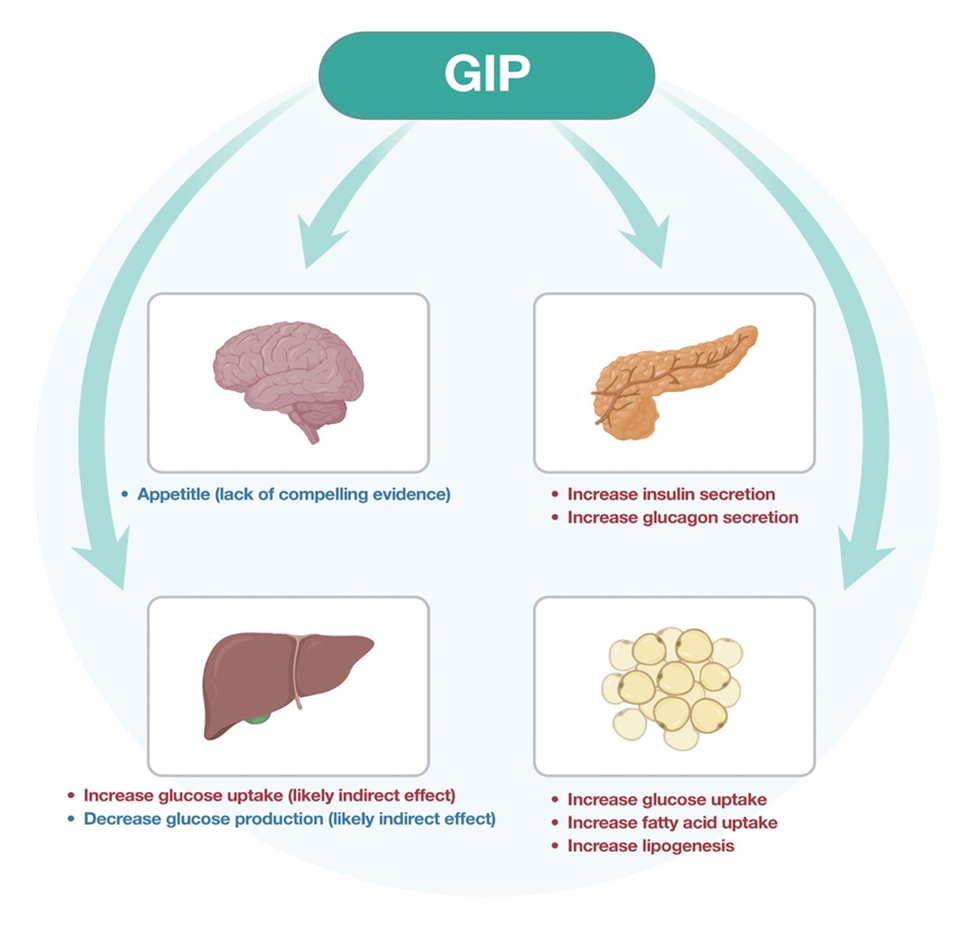
GLP-1
GLP-1 (glucagon-like peptide-1) is another hormone secreted after eating. It sends signals to the brain that promote early satiety, helping reduce hunger and food intake. It also slows down gastric emptying, so the feeling of fullness lasts longer.
GLP-1 supports blood sugar control by enhancing insulin secretion and lowering glucagon levels — a hormone that would otherwise push blood sugar higher. Through these combined effects, tirzepatide improves both post-meal and fasting glucose levels while also making it easier to maintain a calorie deficit for weight loss.
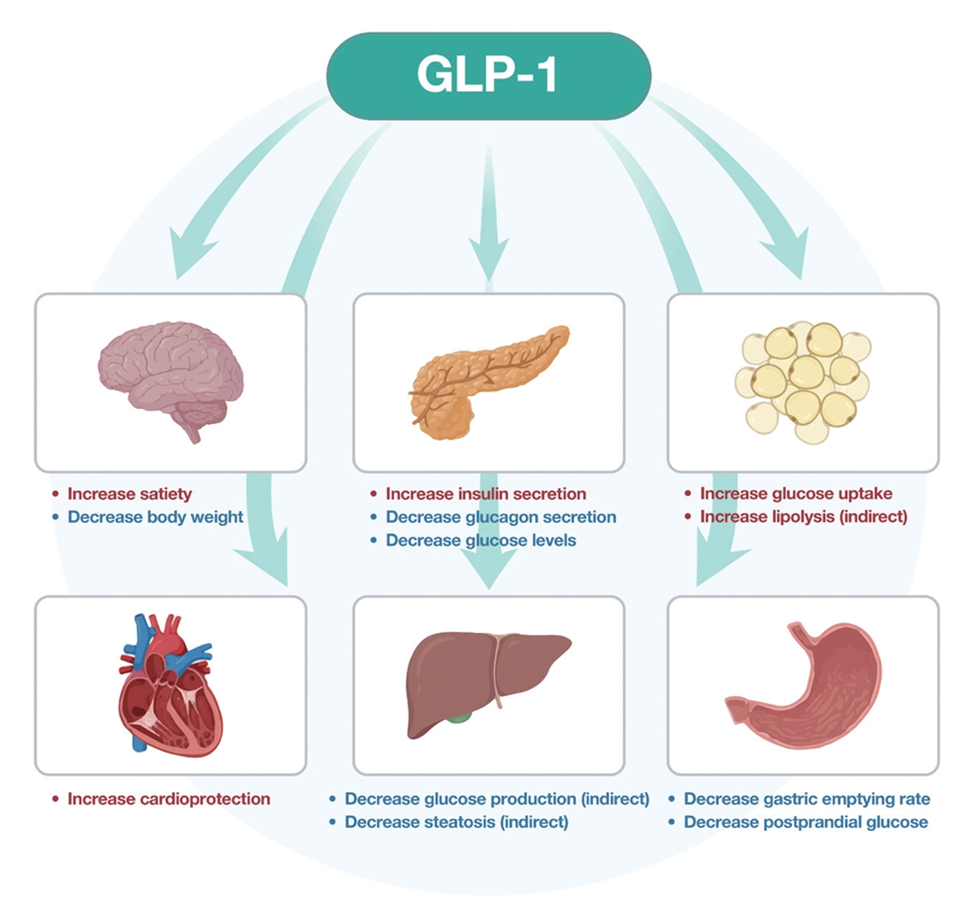
Synergy of GIP and GLP-1
While each hormone has its benefits, the real strength of tirzepatide comes from their combined activation. Together, GIP and GLP-1 provide stronger improvements in blood sugar control, appetite regulation, and fat metabolism compared to targeting either pathway alone. This dual mechanism also supports better beta-cell health, helping preserve the pancreas’s ability to produce insulin over time.
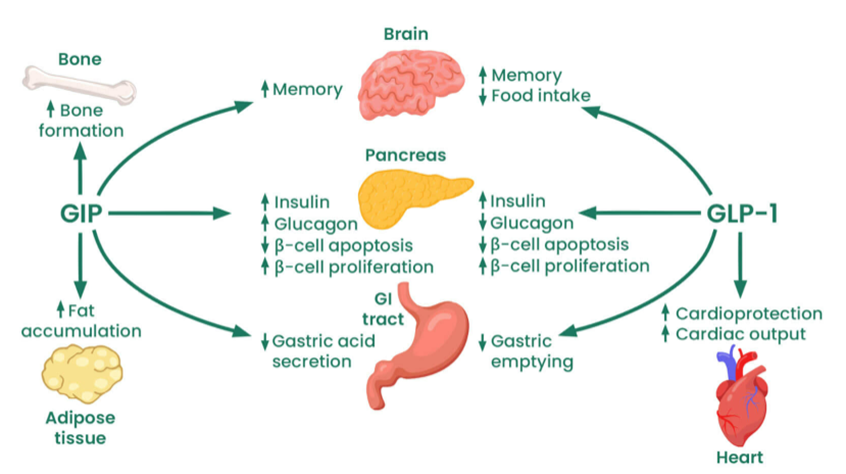
Beyond blood sugar and appetite, tirzepatide positively influences how the body handles fats. It promotes the burning of stored fat for energy, improves cholesterol profiles by lowering LDL ("bad") cholesterol and raising HDL ("good") cholesterol, and reduces visceral fat — the type most closely linked to heart disease and insulin resistance.
Tirzepatide may also lower systemic inflammation and improve blood vessel function, providing additional cardiovascular protection for people with type 2 diabetes or obesity.
Tirzepatide vs Semaglutide vs Retatrutide
Tirzepatide, semaglutide, and retatrutide all belong to the same family of medications — they target hormones that regulate appetite, blood sugar, and metabolism. Tirzepatide may differ in price and cost compared to the others, but it's important not to base your decision solely on that. Understanding how each drug works and what effects it delivers will help you make a more informed choice.
In short:
- Semaglutide activates one receptor (GLP-1)
- Tirzepatide activates two receptors (GLP-1 and GIP)
- Retatrutide activates three receptors (GLP-1, GIP, and glucagon)
| Drug | Receptors activated | Main effects | Average weight reduction (clinical data) |
|---|---|---|---|
| Semaglutide | GLP-1 | Appetite suppression, slower gastric emptying, glucose control | Up to ~15% over 68 weeks |
| Tirzepatide | GLP-1 + GIP | Appetite control, blood sugar regulation, enhanced insulin action, improved fat metabolism | Up to ~22.5% over 72 weeks |
| Retatrutide | GLP-1 + GIP + glucagon | All above + increased energy expenditure and stronger fat burning | Up to ~24% over 48 weeks |
Tirzepatide has already completed all required clinical trials and is approved for use worldwide. Among the medications that are fully studied and widely available, it is currently the most effective — offering stronger improvements in blood sugar control and greater weight loss compared to semaglutide. It combines a high level of effectiveness with a favorable safety profile, making it one of the most powerful treatments available today.
FAQ
Do I need a prescription to buy Tirzepatide?
Yes, Tirzepatide is a prescription medication.
Does Tirzepatide require injections?
Yes, Tirzepatide is administered as a once-weekly subcutaneous injection.
Is Tirzepatide available without prescription?
Yes, on our website Tirzepatide can be purchased without a prescription. Here, Tirzepatide is available online, with clear instructions and support.
How long can I stay on Tirzepatide?
There’s no strict limit — treatment can continue as long as it remains effective and well-tolerated.
Is it safe to buy Tirzepatide online?
It can be safe if purchased from a trusted online source, but always verify authenticity and local laws. Avoid unverified sellers to reduce risk. We offer Tirzepatide for sale with clear quality standards and reliable delivery.

